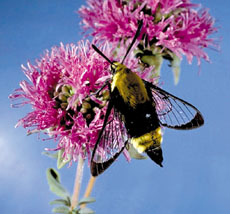Moths have long been the underdogs of the insect world. Though they belong to the same order as butterflies and have the same, if not greater, ecological significance, their general lack of color has often cast them as poor cousins to the butterfly. But what the moths lack in form, they certainly make up for in substance. According to latest published research, it is now known that some moths have the unique ability to distinguish color at night.
Hawkmoths are among the most impressive of all moths. Their large wings and aerodynamic bodies make them perfectly adapted for fast flight. Like hummingbirds, the hawkmoths can hover over flowers while sucking nectar through their extremely long tongues. They also have an acute sense of smell and use it to zero in on potential mates. The complex courtship ritual involves sexually stimulating pheromones, love songs and aerobatic maneuvers. Until recently this highly developed olfactory system was thought of as the hawkmoths’ chief navigational guide. But the hawkmoths’ ability in avoiding `flower accidents’ and recognizing a mate’s colored signals in almost total darkness, puzzled scientists.
According to Prof Richard White of the UMB biology department, hawkmoths have three spectral types of photoreceptors allowing for trichromatic colour vision just as humans have it – not quite the same though – and the receptors, like those of most insects, are sensitive to ultraviolet, blue and green light. To study how this system really works, his team cloned the visual pigments to find the structure of proteins from RNA in the hawkmoth retina. The aim was to use this protein sequence to construct antibodies specific to each pigment. Knowledge of how these antibodies react with various cells can reveal secrets of hawkmoth vision.
But success in proving color vision in hawkmoths has been elusive. Though the research team set up special feeding stations in the lab and was able to prove the hawkmoths’ spectral sensitivity (attraction to blue and repulsion to ultraviolet), they were unable to conclusively show that the hawkmoths could distinguish between various wavelengths. “One of our students had evidence to prove it but we thought the results were not conclusive. The problem was we had to train the moths to choose between various colors (or wavelengths),” says White.
That success went to researchers at Lund University, Sweden, and the results were promptly published in recent issues of Nature and NewScientist. The Vision Group at Lund not only trained the moths to pick out artificial blue and yellow flowers from various other flowers, it was able to make them do the same in conditions close to starry moonless nights. According to team leader Almut Kelber, though the moths were unable to choose between various shades of a color, they were able to choose between various colors. That proved beyond doubt the moths were seeing color.
But training the moths wasn’t easy. According to Kelber, “Prof. White works on the Manduca sexta which is difficult to train. I have not been able to train this species myself. However, I used experience in training the diurnal hummingbird hawkmoth eight years ago. They learn colors very fast and can even be trained to discriminate patterns. Training the nocturnal elephant hawkmoth proved much more difficult, but it worked.”
So what is the next step in hawkmoth vision research and what questions remain unanswered? According to White, and fellow scientists Prof Robert Stevenson and Ruth Bennet, who have done extensive field studies in Costa Rica, ” we are now conducting research into hawkmoth behavior”. One area of interest is to find whether hawkmoths can see polarized light. This is important as a clear sky has a marked pattern comprising this kind of light and many animals are known to use it for navigation. “Though we do not yet know the level of sensitivity we suspect it is probably ultraviolet and our team will shortly be submitting a paper to the Journal of Experimental Biology,” says White.
Interestingly, the group at Lund too is looking into hawkmoth vision in polarized light and has similar goals. “We are trying to understand how the moths use different stimuli that guide them to food, and how they make choices. We have, for instance, started to work on odor and visual orientation in a wind tunnel, and performed a detailed study on color and place learning,” says Kelber. “Different species might rely on innate preferences to different degrees, and the experiments performed on Manduca sexta in Boston prove nicely, that this species relies very much on innate behavior. The species I worked on seem to be more flexible in their behavior,” she adds.
White attributes the increased interest in hawkmoth vision to economic and ecological concerns. Hawkmoths are known to fly great distances for food and as much as ten per cent of tropical flora depends on them for pollination. In fragmented tropical forests the hawkmoth helps promote greater biodiversity, further underlining the global ecological significance of this research. The group at Lund on the other hand is looking at various medical and technical applications. The team hopes to translate some of its knowledge into development of a new generation of digital cameras that can perform flawlessly even in pitch darkness.





















































